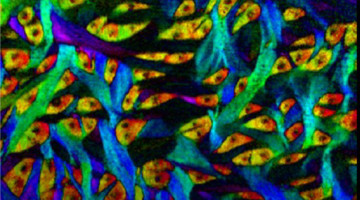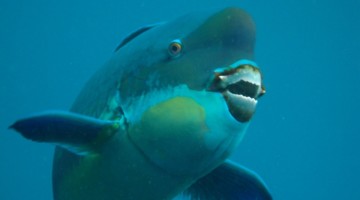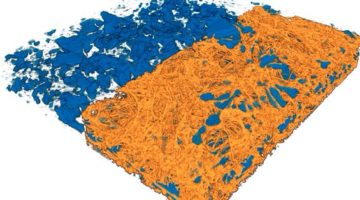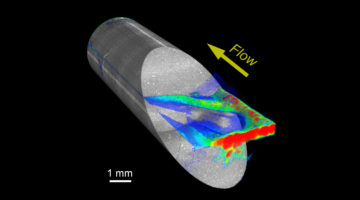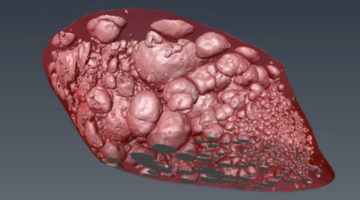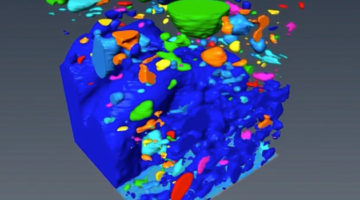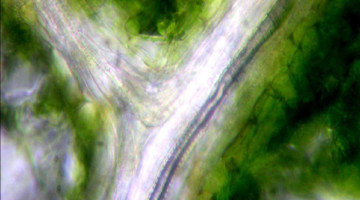TE Connectivity used ALS microtomography capabilities to optimize the material and manufacturing parameters of their conductive plastics to impart good electrical conductivity. Conductive plastics with good electrical properties offer processing and cost benefits over metal alternatives, with applications ranging from automotive to data communications. Read more »
The Microstructure of a Parrotfish Tooth Contributes to Its Toughness
Parrotfish chew on coral, producing hundreds of pounds of sand each year. Mapping the microstructure of parrotfish teeth, scientists found bundles of crystals interwoven like chain mail. The results provide a blueprint for creating ultra-durable materials for mechanical components that undergo repetitive contact, movement, and abrasion. Read more »
X-Rays Reveal the Biting Truth About Parrotfish Teeth
A parrotfish’s hardy teeth allow it to chomp on coral all day long, ultimately grinding it up through digestion into fine sand. Researchers wanting to see how the fine crystal structure of parrotfish teeth contribute to their incredible strength were able to visualize the orientation of individual crystals, which showed their intricately woven structure. Read more »
Fuel Cell X-Ray Study Details Effects of Temperature and Moisture on Performance
A specialized type of hydrogen fuel cell requires precise temperature and moisture controls to be at its best. But seeing inside a working fuel cell at the tiny scales relevant to a fuel cell’s chemistry and physics is challenging, so scientists used x-ray-based imaging techniques to study their inner workings. Read more »
Fracture Evolution in Carbonate-Rich Shale
Accurate assessment of the suitability of subsurface rock formations for CO2 containment requires a good understanding of fracture evolution. Researchers combined x-ray microtomography with advanced computer simulations to improve models of fracture development in carbonate-rich shale samples. Read more »![]()
![]()
PepsiCo Explores Future Food Products at the ALS
Global food and beverage giant PepsiCo has been using ALS tomography beamline 8.3.2 to understand more about the chemical structure and behavior of their starch-based snack foods, with the goal of creating a whole new category of snacks that consumers cook at home in their own microwaves. Read more »![]()
In Situ Electrical Resistance and X-Ray Tomography Study of Copper–Tin Polymer Composites during Thermal Annealing
In situ electrical conductivity and x-ray tomography experiments were conducted on a conductive polymer composite containing polyvinylidene fluoride (PVDF) copolymer, copper (Cu), and tin (Sn) during thermal annealing. This study provides detailed insight into the morphological origins of the beneficial effect of thermal annealing on the electrical properties of conductive composites containing low melting metal fillers. Read more »
ALS Gives Intel a Closer Look at Microelectronic Packages
Intel, the world’s largest semiconductor chip maker, has been using the tomography capabilities at the ALS to image their microelectronic packages in 3D at high resolution with short throughput time, providing valuable information for both failure analysis and product development and proving that synchrotrons are an insightful tool for this type of imaging. Read more »![]()
How X-rays Helped to Solve Mystery of Floating Rocks
Some rocks can float on water for years at a time before eventually sinking. X-ray microtomography studies help explain how by scanning samples of lightweight, glassy, and porous volcanic rocks known as pumice stones. Their surprisingly long-lived buoyancy can help scientists discover underwater volcano eruptions. Read more »
3D Visualization of Leaves during Drought
The veins of living leaves at increasing levels of drought stress were visualized using x-ray microtomography. The results expand our view of leaf drought responses, beyond the traditional embolism-centric view, to a broader focus on the role of the surrounding living tissues in water movement during drought. Read more »

